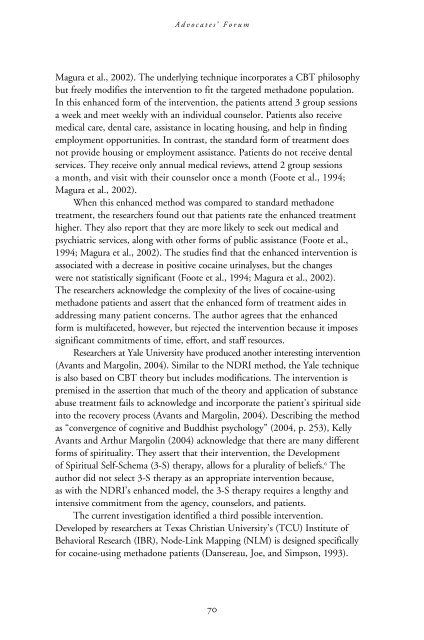2006 - School of Social Service Administration - University of Chicago
2006 - School of Social Service Administration - University of Chicago
2006 - School of Social Service Administration - University of Chicago
You also want an ePaper? Increase the reach of your titles
YUMPU automatically turns print PDFs into web optimized ePapers that Google loves.
Advocates’ Forum<br />
Magura et al., 2002). The underlying technique incorporates a CBT philosophy<br />
but freely modifies the intervention to fit the targeted methadone population.<br />
In this enhanced form <strong>of</strong> the intervention, the patients attend 3 group sessions<br />
a week and meet weekly with an individual counselor. Patients also receive<br />
medical care, dental care, assistance in locating housing, and help in finding<br />
employment opportunities. In contrast, the standard form <strong>of</strong> treatment does<br />
not provide housing or employment assistance. Patients do not receive dental<br />
services. They receive only annual medical reviews, attend 2 group sessions<br />
a month, and visit with their counselor once a month (Foote et al., 1994;<br />
Magura et al., 2002).<br />
When this enhanced method was compared to standard methadone<br />
treatment, the researchers found out that patients rate the enhanced treatment<br />
higher. They also report that they are more likely to seek out medical and<br />
psychiatric services, along with other forms <strong>of</strong> public assistance (Foote et al.,<br />
1994; Magura et al., 2002). The studies find that the enhanced intervention is<br />
associated with a decrease in positive cocaine urinalyses, but the changes<br />
were not statistically significant (Foote et al., 1994; Magura et al., 2002).<br />
The researchers acknowledge the complexity <strong>of</strong> the lives <strong>of</strong> cocaine-using<br />
methadone patients and assert that the enhanced form <strong>of</strong> treatment aides in<br />
addressing many patient concerns. The author agrees that the enhanced<br />
form is multifaceted, however, but rejected the intervention because it imposes<br />
significant commitments <strong>of</strong> time, effort, and staff resources.<br />
Researchers at Yale <strong>University</strong> have produced another interesting intervention<br />
(Avants and Margolin, 2004). Similar to the NDRI method, the Yale technique<br />
is also based on CBT theory but includes modifications. The intervention is<br />
premised in the assertion that much <strong>of</strong> the theory and application <strong>of</strong> substance<br />
abuse treatment fails to acknowledge and incorporate the patient’s spiritual side<br />
into the recovery process (Avants and Margolin, 2004). Describing the method<br />
as “convergence <strong>of</strong> cognitive and Buddhist psychology” (2004, p. 253), Kelly<br />
Avants and Arthur Margolin (2004) acknowledge that there are many different<br />
forms <strong>of</strong> spirituality. They assert that their intervention, the Development<br />
<strong>of</strong> Spiritual Self-Schema (3-S) therapy, allows for a plurality <strong>of</strong> beliefs. 6 The<br />
author did not select 3-S therapy as an appropriate intervention because,<br />
as with the NDRI’s enhanced model, the 3-S therapy requires a lengthy and<br />
intensive commitment from the agency, counselors, and patients.<br />
The current investigation identified a third possible intervention.<br />
Developed by researchers at Texas Christian <strong>University</strong>’s (TCU) Institute <strong>of</strong><br />
Behavioral Research (IBR), Node-Link Mapping (NLM) is designed specifically<br />
for cocaine-using methadone patients (Dansereau, Joe, and Simpson, 1993).<br />
70
















